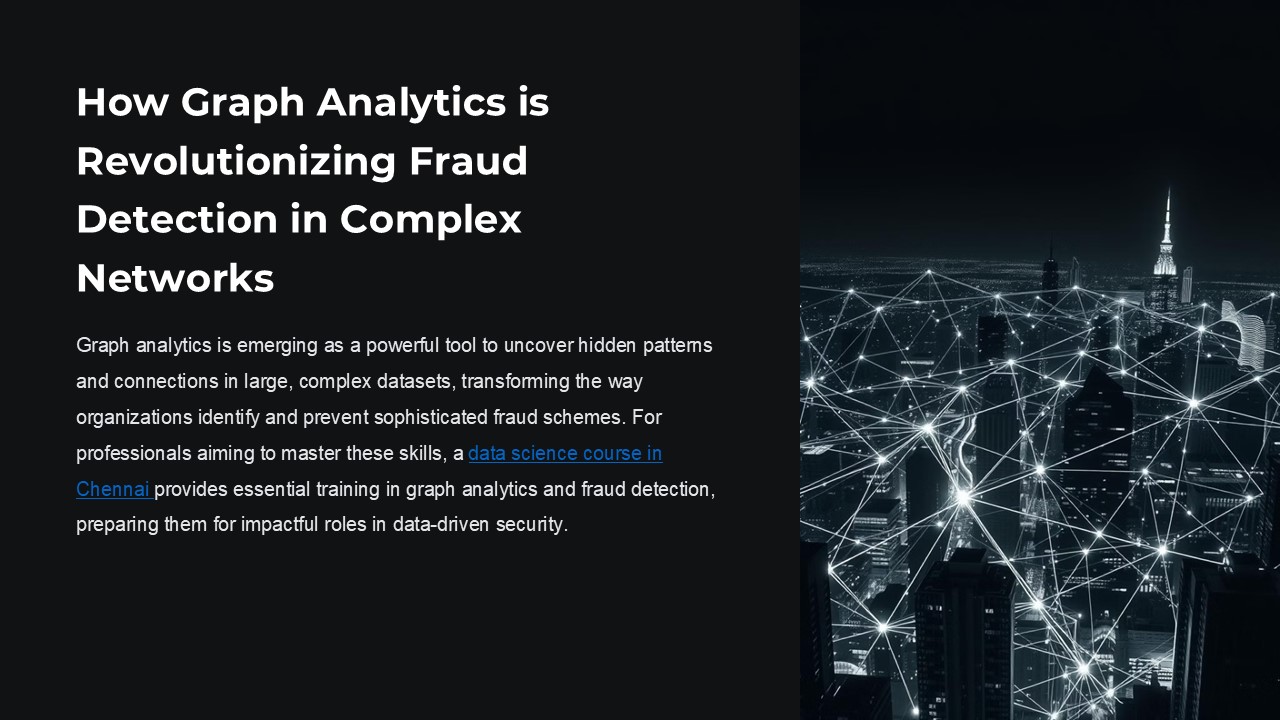How Graph Analytics is Revolutionizing Fraud Detection in Complex Networks
Title:
How Graph Analytics is Revolutionizing Fraud Detection in Complex Networks
Description:
Graph analytics is transforming fraud detection by revealing hidden connections in complex networks, enabling organizations to identify fraud more effectively. A data science course in Chennai provides essential training in these techniques, preparing professionals for impactful roles in fraud prevention. –
Number of Views:0
Date added: 5 November 2024
Slides: 9
Provided by:
channa13
Category:
How To, Education & Training
Tags:
Title: How Graph Analytics is Revolutionizing Fraud Detection in Complex Networks
1
How Graph Analytics is Revolutionizing Fraud
Detection in Complex Networks
Graph analytics is emerging as a powerful tool to
uncover hidden patterns and connections in large,
complex datasets, transforming the way
organizations identify and prevent sophisticated
fraud schemes. For professionals aiming to master
these skills, a data science course in Chennai
provides essential training in graph analytics
and fraud detection, preparing them for impactful
roles in data-driven security.
2
Introduction to Fraud Detection Challenges
Vast Data Volumes
Complex Relationships
1
2
Rapidly growing transaction data makes it
difficult to manually inspect for anomalies.
Fraudsters exploit intricate networks of
accounts, entities, and behaviors to cover their
tracks.
Evolving Tactics
3
Fraud schemes constantly adapt, requiring agile
detection approaches beyond rule-based systems.
3
Limitations of Traditional Approaches
Siloed Data
Static Rules
Lack of Context
Isolated data sources prevent seeing the full
picture of fraudulent activity.
Rule-based systems struggle to keep up with
evolving fraud tactics.
Inability to understand complex relationships and
behavioral patterns.
4
The Power of Graph Analytics
Interconnectivity
1
Graph analytics reveals hidden relationships and
patterns across vast datasets.
Anomaly Detection
2
Identifying suspicious activities and outliers
based on network topology.
Predictive Modeling
3
Leveraging graph algorithms to forecast and
prevent future fraud incidents.
5
Leveraging Graph Algorithms for Fraud
Identification
Community Detection
Centrality Analysis
Identifying densely connected clusters that may
indicate coordinated fraud schemes.
Identifying key players and nodes that facilitate
fraudulent activities.
Link Prediction
Anomaly Detection
Forecasting new connections that could signal
emerging fraud networks.
Flagging unusual transaction patterns and
behaviors for further investigation.
6
Case Studies Successful Graph-based Fraud
Detection
Increased Detection Rates
Organizations report 20-30 improvement in
catching fraudulent activities.
Cost Savings
Reduced losses and investigation expenses by
leveraging graph insights.
Stronger Collaboration
Graph analytics fosters cross-functional
partnerships to fight fraud.
7
Integrating Graph Analytics into Existing Fraud
Monitoring Systems
Data Ingestion
Collect and aggregate structured and unstructured
data from diverse sources.
Graph Modeling
Build a connected data model to represent
relationships and patterns.
Anomaly Detection
Apply graph algorithms to surface suspicious
activities for further investigation.
Visualization Insights
Provide intuitive dashboards to enable
data-driven decision making.
8
Conclusion and Future Trends
As fraud schemes continue to evolve, graph
analytics will play an increasingly crucial role
in equipping organizations with the agility and
contextual intelligence needed to stay ahead of
sophisticated criminal networks.































